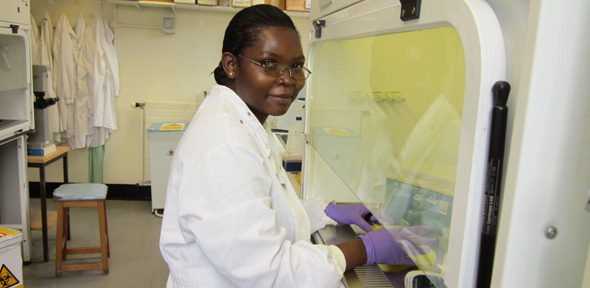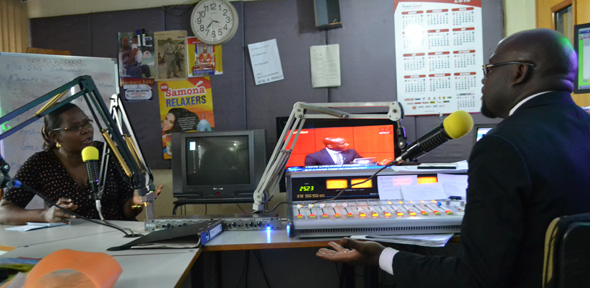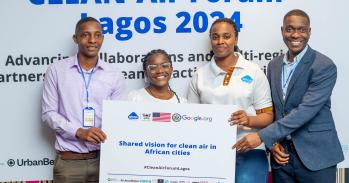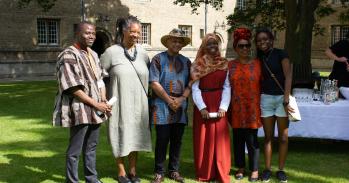
A complication of pregnancy that causes the mother’s blood pressure to rise – often fatally – is more common in women of African descent than any other. Research in Uganda by African and Cambridge researchers is helping to uncover why.
A complication of pregnancy that causes the mother’s blood pressure to rise – often fatally – is more common in women of African descent than any other. Research in Uganda by African and Cambridge researchers is helping to uncover why.
I felt like we were accomplices in this war of sorts. People say we do not remember the words of our enemies but the silence of our friends. I did not want to accept that it was beyond hope
Annettee Nakimuli
As a young doctor in Uganda a few years ago, Dr Annettee Nakimuli was told that nothing could be done about a complication of pregnancy that was putting thousands of pregnant women a year at risk of death.
She remembers the frustration: “I felt like we were accomplices in this war of sorts. People say we do not remember the words of our enemies but the silence of our friends. I did not want to accept that it was beyond hope.”
The disease is pre-eclampsia, a condition that is thought to be caused by the placenta developing abnormally. Women with pre-eclampsia often experience very high blood pressure, which can be fatal without medical intervention. Although the condition affects women worldwide, in African women it is more common and particularly severe. It also occurs earlier in pregnancy and can recur in subsequent pregnancies.
“What makes pre-eclampsia such a challenge is it has been impossible to predict or prevent,” explains Professor Ashley Moffett, from Cambridge’s Department of Pathology and Centre for Trophoblast Research, who is an expert on the disease.
“It’s been called the ‘silent killer’ because many women cannot feel the danger sign that their blood pressure is rising until it’s too late. Even when it is detected the only course of action is constant monitoring, and ultimately the only cure is delivery – sometimes at too early a stage for the baby to survive,” adds Moffett.
The silent killer
Nakimuli knows only too well the difficulties that African women face. Today she’s an obstetrician in Mulago Hospital, Kampala, where 33,000 babies are born each year. It has the highest number of live births of any hospital in the world (around 100 per day), and 15% of pregnancies develop life-threatening complications such as pre-eclampsia, haemorrhage, obstructed labour and sepsis. She describes herself and her colleagues as being “on the front line” in the battle against death in pregnancy and childbirth.
“I would often see women who had had four or more Caesarean sections with no living child – they continued exposing themselves to the danger until they had a baby,” says Nakimuli, who is also a lecturer at Makerere University. “I felt like not sitting back and just saying this is a disease with theories.”
Seven years ago, she began work with Moffett through the Cambridge-Africa Programme, first as a MUII PhD fellow registered at Makerere University, then as a MUII postdoctoral fellow and now as a research collaborator. Based in Kampala throughout, she would periodically travel to Cambridge to learn new techniques, analyse samples and spend time with Moffett trying to unravel why a complex disease is so much worse in Africa.

A few years earlier, Moffett had discovered that, when the placenta is formed, a remarkable ‘boundary-setting’ process occurs between the mother and the fetus deep within the lining of the womb.
“The placenta must invade the mother enough to access nourishment for the growing baby, yet not so much as to penetrate through the uterus,” she explains. “Placentation is a setting up of the territorial boundary between two genetically different individuals – the mother and her baby, who carries genes from the father. It needs to be in exactly the right place for both to survive and thrive.”
Moffett found that maternal immune cells called uterine natural killer cells mediate the compromise between mother and baby. These cells have unique proteins on their surface called killer-cell immunoglobulin receptors (KIRs), which recognise proteins called MHC on the invading fetal cells. Certain combinations of maternal KIR genes and fetal MHC genes are associated with pre-eclampsia, whereas other KIR genes appear to protect against the disease.
But why would women of African descent suffer so much more from pre-eclampsia than other women? “There was an assumption in Africa that there was a socioeconomic reason, like poverty,” says Nakimuli. “I was convinced that there was something biological.”
Nakimuli set about recruiting 750 mothers at Mulago Hospital to what is the largest genetic study of pre-eclampsia conducted in Africa. She collected blood and umbilical cord samples and, in Cambridge, ‘typed’ the DNA to look at all the genetic variation. “It was kind of a high-risk project, but my determination kept my hope alive. I wanted to find big things.”
Her hunch proved right. She found that the KIR genes that protect African women against pre-eclampsia are different from those that protect European women. Moreover, the risky combination of maternal KIR and fetal MHC proteins occurs at a much higher frequency in sub-Saharan Africa than anywhere else in the world.
We think that women of African ancestry may have these risk genes because of certain beneficial selective pressures, otherwise why would genes that kill mothers and babies be so common in the population?
Ashley Moffett
The findings immediately opened up new avenues of research into the biology of pre-eclampsia. The study also has implications for understanding infectious diseases, as Moffett explains: “We think that women of African ancestry may have these risk genes because of certain beneficial selective pressures, otherwise why would genes that kill mothers and babies be so common in the population? People with the gene that causes sickle-cell anaemia are able to fend off malaria – perhaps something similar is happening for KIR genes? And so now we are starting work to see whether the genes are protecting against infections such as measles, HIV and malaria.”
Africa's Voices
While Nakimuli and Moffett continue pinpointing the genetic basis of pre-eclampsia, and hope to bring out the first comprehensive textbook on African obstetrics, they are aware that one of the key issues surrounding pregnancy is that too many African women go to hospital too late, leaving it until their complications are advanced and dangerous.
“There’s a general lack of awareness and understanding,” explains Nakimuli. “There isn’t even an Ugandan word for pre-eclampsia. The closest people get to describing the condition is ‘having hypertension which is different from the other hypertension when you’re not pregnant’. It becomes a mouthful.”
Last year she took part in a series of radio programmes in Uganda as ‘Doctor Annettee’, the on-air doctor ready to answer questions from the audience. The programmes were part of an innovative Cambridge-led research project, ‘Africa’s Voices’, which uses interactive radio and mobile communications to gather and analyse the views of ordinary citizens.
“Because of the high rates of maternal mortality, a coping mechanism among Ugandan women is to consider pregnancy as being about bravery and fortitude,” says Nakimuli. “This way of coping might however lead to late self-diagnosis of the warning signs.”
“Sociocultural beliefs like coping mechanisms will determine how people behave,” says Dr Sharath Srinivasan, who is Head of Cambridge’s Centre of Governance and Human Rights and leads Africa’s Voices, “and so it’s important to understand a person’s thinking to support better maternal and neonatal health policies.”
However, the challenge has always been how to collect and assess all of the different ‘voices’ from hard-to-reach African communities. Srinivasan and colleagues realised that Africa’s digital revolution – particularly the widespread use of mobile phones and SMS messaging – could provide the answer when combined with the huge popularity of local radio stations and the team’s technical know-how.
The team developed a format in which a radio presenter would play a real-life testimonial – such as a woman relaying the complications of her pregnancy – and then invite listeners to reply to a related question by sending a text to a toll-free number. Each respondent would subsequently receive an SMS sociodemographic survey to complete.

“What makes this set-up so rich is the fact that ordinary citizens are encouraged to voice their views. They aren’t restricted by a poll-style yes/no answer,” says Srinivasan. “We’ve developed a methodology that can take this data, which is often complex, unstructured and in more than one local language, and analyse it with qualitative social science and computational techniques to draw out key themes and insights.”
During Africa’s Voices pilot phase, the team used this format in eight sub-Saharan countries, working with nine radio stations, and choosing radio presenters who have a good relationship with their audience. In these ‘social spaces’, they probed beliefs on HIV/AIDS, vaccination, women’s issues, agriculture and governance processes.
Now spun-out of the University as a non-profit organisation, Africa’s Voices works in East Africa with NGOs, health agencies and media organisations, and maintains strong links with researchers such as Nakimuli and Moffett.
An interactive radio project to shed light on pregnancy complications like pre-eclampsia was recently completed with three local language radio stations in Kampala, Uganda, and rich insights emerged into the perceived causes of complications in pregnancy. One finding is the difference in beliefs between men and women.
“Men, more than women, tend to think that the causes of complications are related to enduring traits of the mothers – their biology or their personality – but that the risk of complications is more likely to happen to other women, not their own partner,” explains Srinivasan.
“Women on the other hand are more likely to believe that complications arise because of factors that they can control – such as their lifestyle. Both women and men agree that insufficient health provision is the major reason women delay seeking healthcare.”
Srinivasan suggests from his experience that governments and service deliverers are keen to listen intelligently to what people are saying and to organise their work more attentively to the world views and collective beliefs of the populations they serve. “Sociocultural beliefs that limit the seeking of healthcare are addressable,” he says. “Interventions that engage women and communities in conversations can help change beliefs, opinions and norms, and thus behaviour patterns.”
"We needed to study the disease in Africa"
When Nakimuli is asked what her own research findings on the genetics of pre-eclampsia will mean for the mothers she sees every day on the wards at Mulago hospital, she is pragmatic.
“Can it help medically? We are still far from that,” she says. “Yes, theoretically we can predict risk by genotyping pregnant mothers, but we are in a low-resource setting – everything needs to be cost-effective. Really we need to develop a bedside test that doesn’t require costly and time-consuming laboratory analysis. Then we could know which women need to be monitored carefully.”
Sociocultural beliefs that limit the seeking of healthcare are addressable. Interventions that engage women and communities in conversations can help change beliefs, opinions and norms, and thus behaviour patterns
Sharath Srinivasan
In the seven years since Nakimuli first embarked on her studies to understand why so many women die in pregnancy, Cambridge-Africa research partnerships with Mulago Hospital have widened considerably. They now include pharmacist Dr Ronald Kiguba and Professor Sheila Bird OBE (Medical Research Council Biostatistics Unit, Cambridge) investigating how to report medication errors and adverse drug reactions; microbiologist Dr David Kateete and Professor Stephen Bentley (Wellcome Trust Sanger Institute) tracking how infections like MRSA spread through hospitals; and a group of obstetricians and midwives from Cambridge University Hospitals NHS Foundation Trust looking at best practice with their contemporaries in Kampala.
Meanwhile, a typical day at Mulago Hospital will bring around five pre-eclamptic pregnancies and several cases of obstructed labour, preterm birth and stillbirths; and a team of five doctors will be supervising 80–100 deliveries.
Funds are being sought by Cambridge-Africa to help set up an African Centre of Excellence in Pregnancy and Childbirth at Mulago Hospital, in partnership with Makerere University’s College of Health Sciences. “We would like to train more specialised staff who in turn will train the next generation, and we want to turn new understanding of pregnancy complications into clinical interventions,” explains Nakimuli.
Looking back to when she decided not to accept that nothing could be done about pre-eclampsia, Nakimuli says: “I was convinced that the reason we didn’t know much about the disease was because we’d been looking in the wrong place. We needed to study the disease in Africa. After all, if you want to study a disease properly, then you should look at the population most affected by it.”
Dr Annettee Nakimuli was funded by the Makerere University-Uganda Virus Research Institute Infection and Immunity Research Training Programme (MUII).
Inset images: Top: Dr Annettee Nakimuli; Bottom: radio interview with 'Dr Annettee' at Akaboozi FM in Kampala, Uganda, as part of the Africa's Voices study (credit: Rainbow Wilcox, Africa's Voices).
To keep up to date with the latest stories about Cambridge’s engagement with Africa, follow #CamAfrica on Twitter.
Graduate, get a job … make a difference #6
Cambridge graduates enter a wide range of careers but making a difference tops their career wish lists. Read about Kathryn Savage who now works in Uganda to improve health service delivery and increase utilisation by strengthening the leadership skills of health workers and district health teams. 'Graduate, get a job … make a difference' is a series in which inspiring graduates from the last three years describe Cambridge, their current work and their determination to give back.

The text in this work is licensed under a Creative Commons Attribution 4.0 International License. For image use please see separate credits above.




